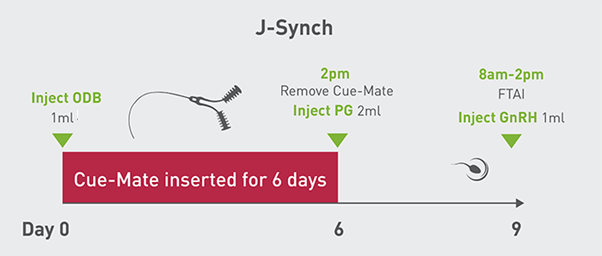JSync image.png

The use of hormone-based products in animals has become increasingly controversial over time. Oestradiol-based hormones were banned altogether in NZ in 2007 and a voluntary ban was put in place in the Australian dairy industry soon after.
The ongoing question seems not so much if, but when would all oestradiol-based products also be banned, either forcibly or voluntarily, in the Australian beef industry? And following on from that, what would beef cattle reproduction look like without the use of oestradiol-based hormones?
This article looks at implications for the Australian beef industry should oestradiol-based hormones be banned.
Assisted Reproduction in a World without Oestradiol
The use of hormone-based products in animals has become increasingly controversial over time. The focus has generally been on hormone growth implants (HGP’s) however, a number of reproduction drugs have been included in the resulting decisions not only by policy makers, but also in the form of voluntary withdrawal of products by industry and pharmaceutical companies themselves.
In the early 1980’s, the EU banned the use of substances having a hormonal action for growth promotion in farm animals, which then had an impact on countries exporting animal products to the EU. The ban was based on fears that residues in animal products could have dire consequences such as increasing the risk of cancer or resulting in the premature onset of puberty in children. The scientific evidence in support of the ban is far from compelling and has since been questioned repeatedly.
Despite the lack of scientific evidence, consumer pressure has continued to mount over the last 15 years and it is likely that further products, such as some of those used in bovine reproduction, will come under scrutiny and may subsequently be removed. Oestradiol-based hormones are commonly used in many beef oestrous synchrony programs and has become a mainstay in the cattle reproduction world. When used in a Fixed Time AI (FTAI) program, together with an intravaginal progesterone releasing device such as Cue-Mate®, oestradiol benzoate, for example, gives reliable, affordable and predictable results.
Oestradiol-based hormones however were banned altogether in NZ in 2007 and a voluntary ban was put in place in the Australian dairy industry soon after. Faced with the abrupt removal of ODB in NZ, both the beef and dairy industries relied heavily on overseas data (largely the USA where ODB isn’t used in assisted breeding) and scientists with overseas experience to help implement new programs using GnRH and PG instead of ODB. The first year using these new programs had a few challenges but generally the results were equivalent to the previous ODB-based programs and producers have been using these alternate products and programs since.
The ongoing question seems not so much if, but when would all oestradiol-based products also be banned, either forcibly or voluntarily, in the Australian beef industry? And following on from that, what would beef cattle reproduction look like without the use of oestradiol-based hormones?
Fortunately it is possible to manipulate the bovine oestrus cycle and achieve the same outcome, using alternative drugs to oestradiol.
A combination of GnRH (gonadotrophin releasing hormone) and PG (Prostaglandin F2α) can be incorporated in synchrony programs which is commonly referred to as the ‘Ovsynch’ or GPG program. This is the program typically used in EU accredited herds.
In this program, an initial injection of GnRH on Day 0 forces ovulation of any larger follicles thereby recruiting a new wave of follicles. Once the resulting CL (corpus luteum) is lutalysed by means of a PG (prostaglandin) injection on Day 7, there is no longer progesterone suppression, and these developing follicles are free to progress to ovulation.
Ovulation can be triggered by a second GnRH injection on Day 9, thereby achieving a tighter synchrony allowing for fixed-time insemination (FTAI) either 16-20 hours post GnRH injection, or even combined with FTAI (‘Cosynch’) with some adaptation of timing.
The incorporation of a Cue-Mate® progesterone releasing device (between Day 0 and Day 7 (GPG+P4 programs) further enhances the results of the ‘Ovsynch’ programs by recruiting and synchronising animals which haven’t properly responded to the first GnRH injection, thereby increasing the conception rates to FTAI. This progesterone also provides the necessary priming to induce cyclicity in animals which are pre-pubertal (heifers), or may be in some form of anoestrus (e.g. low body condition, suckling anoestrus or late calving).
Study results from local and global research have shown similar conception and pregnancy rates when comparing ODB-based programs with these GPG type programs, both in dairy and beef reproduction programs, so we can be assured that there are good alternatives if ODB is no longer allowed.
But there are some downsides and significant differences with implementing the GPG type programs:
- The drugs are significantly more expensive due to the cost of the active ingredients and this increases the overall cost of synchrony programs (by approximately 15% - NZ Data).
- Oestradiol directly causes signs of heat/oestrus so a high proportion of cows in synchronisation programs exhibit oestrus behaviour at the time of FTAI, whereas GPG programs often trigger ovulation before the follicle is producing oestrogen and therefore the cow will not show signs of oestrus even though ovulation is occurring. This is a major difference between the programs and requires a ‘leap of faith’ where all cattle are inseminated to FTAI even though not all cows are demonstrating oestrus/ heat.
- AI technicians may also observe a different feel of the tissues in the genital tract since the lack of oestrogen results in different tissue tones and again this requires a ‘leap of faith’ where all animals are inseminated to FTAI at the appropriate time, and not based on oestrus observation.
Beef producers in New Zealand, where oestradiol was banned entirely in food producing animals, have had over a decade to adapt to GPG programs which have undergone some further refinements to reduce the number of handlings required whilst maintaining pregnancy rates.
Overall, New Zealand reproduction experts agree that there has been no drop in fertility outcomes by changing to GPG programs and oestradiol is just a memory now in NZ.
We can conclude that a withdrawal or ban of oestradiol from beef reproduction programs in Australia wouldn’t have a catastrophic impact given the availability of scientifically proven drug alternatives. There would however be a crucial changeover period where beef producers and reproduction teams would have to adapt to the new programs and accept a higher cost.
Cue-Mate® is a registered trademark of Vetoquinol.
Hughes P & Oswald A. Initial experiences with synchronised fixed time AI programmes in beef cattle without oestradiol. Proceedings of the Society of Sheep and Beef Cattle Veterinarians of the NZVA, 2008
Laven R., Life without Oestradiol Benzoate – AI Syncrony in cattle. Proceedings of the Society of Sheep and Beef Cattle Veterinarians of the NZVA, 2008
Malmo J. et al, Comparison of two treatments of anovulatory anoestrous in postpartum dairy cows, one treatment using a gonadotropin-releasing hormone (GnRH), progesterone, prostaglandin f2, GnRH regimen and the other using a progesterone and oestradiol benzoate regime.
McDougall S., J. Effects of treatment of anoestrous dairy cows with gonadotrophin-releasing hormone, prostaglandin and progesterone. Dairy Sci 93:1944-1959
McDougall S, Cullum A, Anniss FM and Rhodes FM. Treatment of anovulatory anoestrous postpartum dairy cows with a gonadotropin-releasing hormone (GnRH), prostaglandin F2, GnRH regimen or with progesterone and oestradiol benzoate. New Zealand Veterinary Journal 49(5), 168-172, 2001

